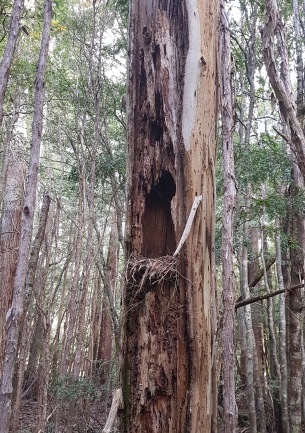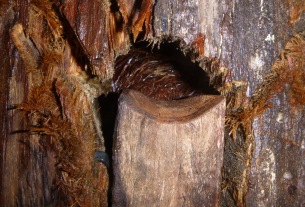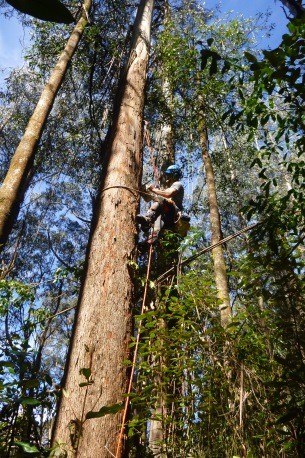Natural hollows, introduced hollows, nest boxes

Many animals use hollows, and lots of those are obligate hollow users – meaning they need access to hollows to survive and/or breed. There is much that is not known about hollows their formation and the relationship with the fauna that use them. It is very clear however that as we remove, or fail to protect habitat, fauna is adversely impacted.
Of primary importance should be the protection and rehabilitation of existing habitat, however in any regenerating site there will exist a significant shortfall of larger mature trees and therefore in these areas there will be a dearth of natural hollows. Where natural hollows are scarce nest boxes and introduced cavities (chainsaw hollows) can, and have, been employed to assist re-establish populations of hollow using fauna.
Treetec has worked on many projects using both nest boxes and introduced cavities, installing, maintaining and monitoring those sites, sometimes side by side. Additionally our team have partnered in a number of research initiatives and whilst there are pro’s and con’s with all methods; introduced chainsaw cavities / hollows are preferred to nest boxes in many circumstances. It goes without saying of course that cutting a large wound into a living tree in a high use area where a failure could occur is problematic, it’s all about context.
There have been a number of projects undertaken exploring various strategies to accelerate or introduce hollow formations in trees, these include fungal inoculation, fire, explosive charges and various mechanical methods such as power tools, chainsaws and specialist tools such as the HollowHog.
Nest boxes

This project included the installation of temperature data loggers.
Nest boxes provide a relatively quick solution where hollows are needed, they can be constructed off-site to suit the target fauna species and are quickly installed. Unfortunately there are a few drawbacks e.g. wooden construction boxes last, on average, only 8-9 years and the thermal properties are quite different from natural cavities. Some of the negative attributes around nest boxes can be mitigated with good design, siting and installation.
Nest boxes are usually constructed from marine ply and then painted, there is little known about the issues around if and how the chemicals in the glues and paint may impact resident fauna.
Recent works with nest box construction is providing better options including insulated layers and the use of composite plastic materials, there is a project running using 3D printed boxes targeting Powerful Owls.
Chainsaw hollows / Introduced cavities in trees
Creating a hollow in a tree that is both suited to a specific fauna species and does not result in the structural failure of the tree is very achievable, although it is early days in terms of scientific evidence.
Treetec has created some thousands of cavities in a range of forest types and urban settings for environmental and research purposes, the uptake by animals has been very high, though not consistently by the target species. There is clearly demand for hollows across various environments. In contrast we have seen a project with the installation of ~300 nest boxes where the uptake was very low (<5% after 1 year), this poor result almost certainly related to the fixing method and aspect of the boxes which highlights the importance of good design and planning.

Introduced cavities can be configured to suit a range of criteria including access for research, placement of sensors, target species, safety, longevity.
Over time the Treetec team has developed innovations around introduced hollows as we’ve learnt how the tree and animals respond. An introduced hollow within a large old tree with decay is very different from an introduced hollow, in a semi-mature tree. Additionally the ability to monitor requires the design to be adapted; this may be facility for electronic installations or access.
Often a man made cavity will be created within the main trunk of the tree however this may not suit some trees and settings, in which case limbs can be used. If perceived risk is an issue a limb can be cut (lopped) back to a stub and the hollow placed within that stub thereby mostly eliminating the risk of failure that might be attributable to the hollow.
Tree hazards and risk
Every tree presents a hazard, the actual risk associated with that hazard is, on average, miniscule. The benefits of trees far outweigh the risks except in a very tiny percentage of cases. Tree related risk is determined by a range of factors:
- Location – busy urban setting – parkland – or forest
- Species – some trees are indestructible, others are highly susceptible to decay and failure
- Age – Old trees are less able to compartmentalise decay than a vigorous semi-mature tree
- Size – a failed limb from 30 metres is quite different to one from 2 metres
- Local environment – edge effect, wind tunnelling, soil, nearby works or interference
- Weather – waterlogged soil in combination with wind immediately alters risk
It is true that cutting into a tree does reduce it’s structural integrity however the actual risk appears to be lower than one might expect.
In summary: a small number of trees in specific settings are, due to risk, not well suited to introduced / man made hollows. However some urban trees and most parks, bushland settings and forests can support introduced cavities without any significant increase in risk to people. These introduced cavities can be designed to be similar in many ways to a natural hollow. They can be accessed for research and have some significant advantages over nest boxes if well designed. Key advantages being that they more closely resemble natural cavities and are cheaper over the medium to longer term.
Key considerations around introduced / chainsaw / hollow hog cavities.
Our team of arborists and ecologists can assist on any canopy access project from arboreal research to the installation of species targeted cavities and hollows.
Please contact us to discuss your project.
